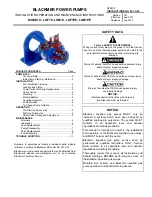
Language Dictionary 6
Series N6700 User’s Guide
91
[SOURce:]DIGital:PIN1:FUNCtion DIO|DINPut|TOUTput|TINPut|FAULt
[SOURce:]DIGital:PIN2:FUNCtion DIO|DINPut|TOUTput|TINPut
[SOURce:]DIGital:PIN3:FUNCtion DIO|DINPut|TOUTput|TINPut|INHibit
[SOURce:]DIGital:PIN4:FUNCtion DIO|DINPut|TOUTput|TINPut
[SOURce:]DIGital:PIN5:FUNCtion DIO|DINPut|TOUTput|TINPut
[SOURce:]DIGital:PIN6:FUNCtion DIO|DINPut|TOUTput|TINPut
[SOURce:]DIGital:PIN7:FUNCtion DIO|DINPut|TOUTput|TINPut
[SOURce:]DIGital:PIN<1-7>:FUNCtion?
These commands set the functions of the digital port pins. The pin
functions are saved in non-volatile memory.
DIO
The pin is a general-purpose ground-referenced digital input/output. The output
can be set with
[SOURce:]
DIGital:OUTPut:DATA <value>.
DINPut
The pin is in digital input-only mode. The digital output data of the
corresponding pin is ignored.
TOUTput
The pin is configured as a trigger output. When configured as a trigger output,
the pin will only generate output triggers if the Step or List transient system has
been configured to generated trigger signals.
TINPut
The pin is configured as a trigger input. When configured as a trigger input, the
pin can be selected as a source of measurement and transient trigger signals.
FAULt
Applies only to pin 1. Setting FAULt means that pin 1 functions as an isolated
fault output. The fault signal is true when any output is in a protected state
(from OCP, OVP, OT, PF, or INH). Note also that Pin 2 serves as the isolated
common for pin 1. When pin 1 is set to the FAULt function, the instrument
ignores any commands to program pin 2. Queries of pin 2 will return FAULt.
If pin 1 is changed from FAULt to another function, pin 2 is set to DINPut.
INHibit
Applies only to pin 3. When pin 3 is configured as an inhibit input, a true signal
at the pin will disable all output channels.
[SOURce:]DIGital:PIN1:POLarity POSitive|NEGative
[SOURce:]DIGital:PIN2:POLarity POSitive|NEGative
[SOURce:]DIGital:PIN3:POLarity POSitive|NEGative
[SOURce:]DIGital:PIN4:POLarity POSitive|NEGative
[SOURce:]DIGital:PIN5:POLarity POSitive|NEGative
[SOURce:]DIGital:PIN6:POLarity POSitive|NEGative
[SOURce:]DIGital:PIN7:POLarity POSitive|NEGative
[SOURce:]DIGital:PIN<1-7>:POLarity?
These commands set the polarity of the digital port pins. The pin
polarities are saved in non-volatile memory.
Setting a polarity to POSitive means that a logical true signal is a
voltage high at the pin. Setting the polarity NEGative means that a
logical true signal is a voltage low at the pin. For trigger inputs and
outputs, POSitive means a rising edge; NEGative means a falling edge.
Summary of Contents for N6700B
Page 1: ...A A A A Agilent Technologies Modular Power System Series N6700 User s Guide...
Page 28: ......
Page 160: ......
Page 168: ......
















































